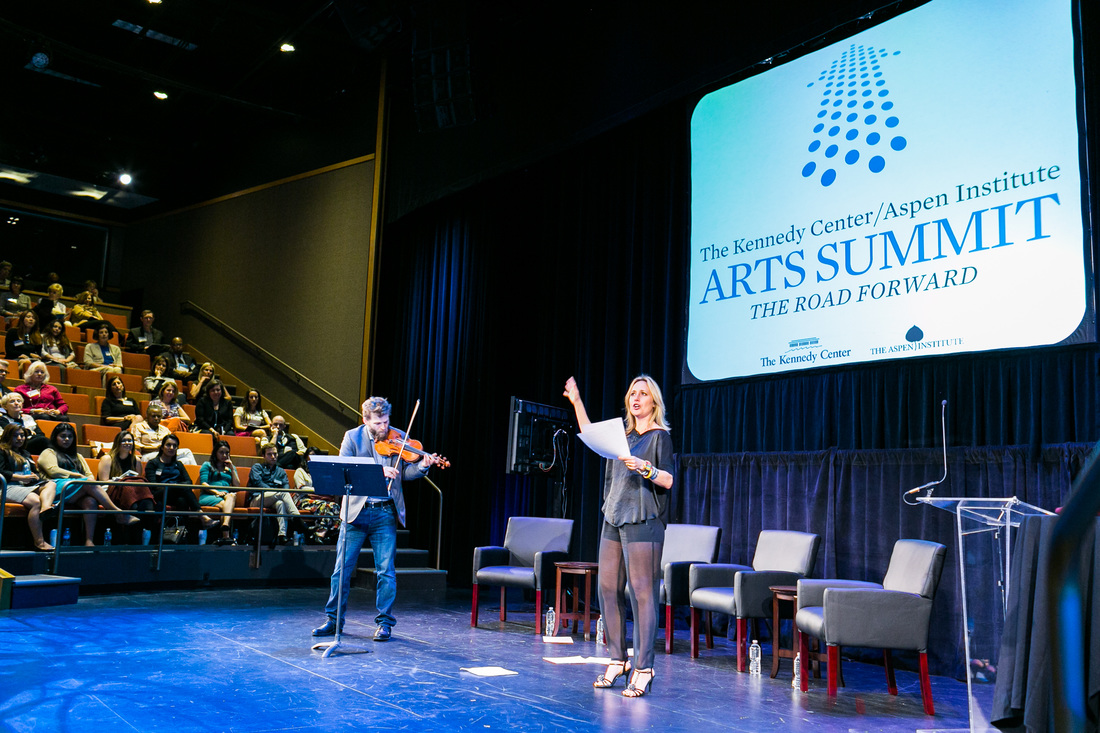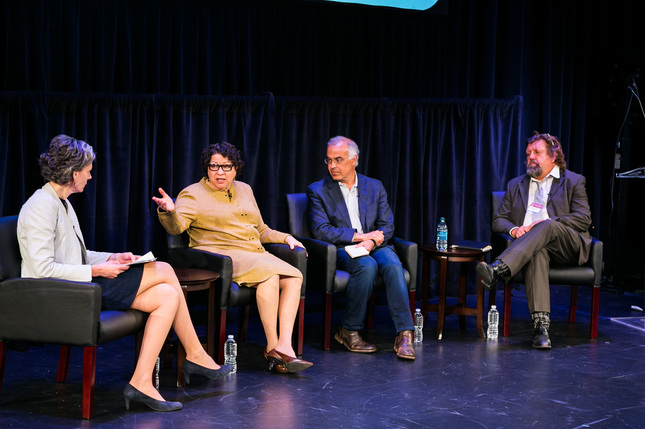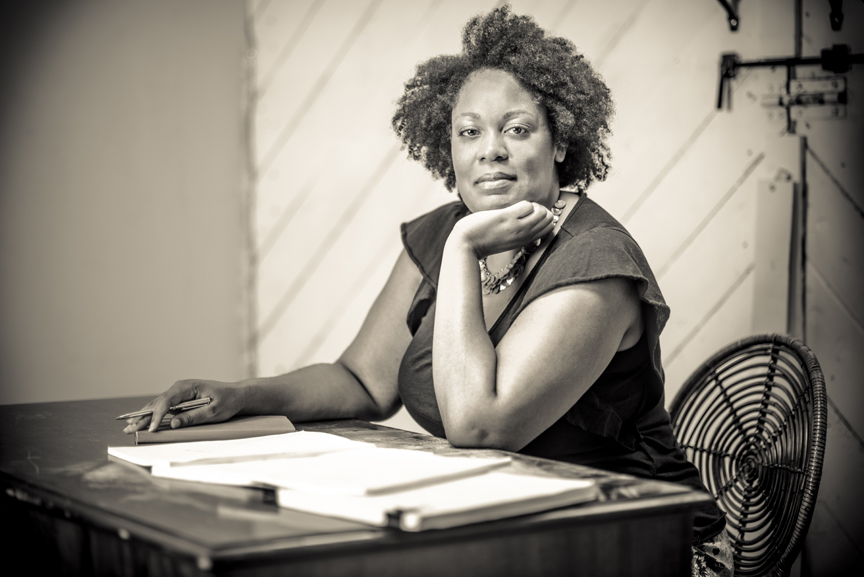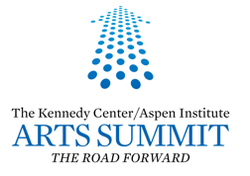 On Saturday, May 16th, I attended the first annual Kennedy Center/Aspen Institute Arts Summit. Organized by former New York City Ballet dancer Damian Woetzel (now Director of the Aspen Institute Arts Program) and by Kennedy Center President Deborah F. Rutter, the day long convening gathered artists, arts and education administrators, civic leaders, and policy makers from around the U.S. We were invited to engage in conversations, enjoy live performances from local and nationally renowned artists, participate in a town hall style debate, and learn from innovative artists, thinkers, and leaders. The focus of our time together was to address issues of race, education, technology, and free speech. Collectively, we were asked to listen, gather information, strategize, and envision a road forward through the arts. 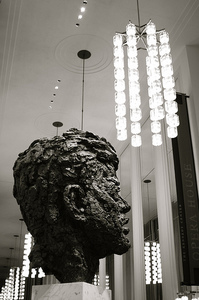 Bust of President John F. Kennedy, designed/created by Robert Berks. Photo by Hitchcock Creative. Bust of President John F. Kennedy, designed/created by Robert Berks. Photo by Hitchcock Creative. The following quote from President John F. Kennedy guided our day: “I am certain that after the dust of centuries has passed over our cities, we, too, will be remembered not for our victories or defeats in battle or politics, but for our contribution to the human spirit.” Last year, I attended the Kennedy Center/DeVos Institute of Arts Management International Arts Leaders Forum, which brought together artists, arts managers, and board members to ask questions, share ideas, and discuss solutions to issues impacting the arts community. The highlight of that weekend was the Performing Arts Symposium, which focus on the careers of performing artists and addressed issues such as changing audience demands, building new audiences, embracing new technology, coping with changes at arts organizations, and building a meaningful career. When I learned about the Arts Summit, I knew that I had to attend and am thankful to Kennedy Center Senior Press Representative Michael Solomon for making it happen. What follows are learnings, discoveries and biggest takeaways from the day. Arts Summit: Welcome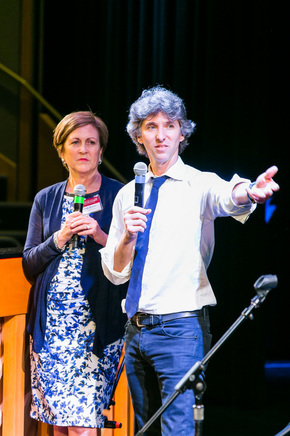 Kennedy Center President Deborah F Rutter and Aspen Institute Arts Program Director Damian Woetzel. Photo Yassine El Mansouri. Kennedy Center President Deborah F Rutter and Aspen Institute Arts Program Director Damian Woetzel. Photo Yassine El Mansouri. After registration and coffee, we were welcomed to the summit by our organizers. Deborah Rutter explained that this event continues the conversation that began year, only they wanted to make a concerted effort to bring artists together with arts administrators. I appreciated this shift as it allowed for the work of artist, administrators, civic leaders, and policy makers to happen together in consideration and reflection of each other. Next, Damian Woetzel asked us to stand and rehearse the opening of George Balachine’s choreography to Peter Tchaikovsky’s Serenade for Strings. (Click here to watch this historical performance here.) Woetzel explained that he invited us to dance to emphasize the fact that when we participate in the arts we do so as part of a continuum and education of the arts. It was beautiful to watch the room move together with such grace and focus. From classical ballet to the jukin’, choppin’ and buckin’ moves of Ron “Prime Time” Myles, I knew we were in for a different kind of conversation around the arts: one that was meant to bring us together and wake us up to the ways that art serves the greater community. Arts Summit: Education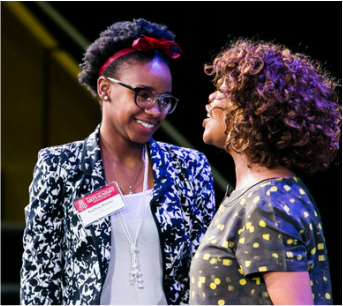 Karlyn Boens and Alfre Woodard. Photo Yassine El Mansouri. Karlyn Boens and Alfre Woodard. Photo Yassine El Mansouri. As a teaching artist and assistant professor at the University of North Carolina- Chapel Hill in the Department of Dramatic Art, I was particularly interested in this conversation. David Rubenstein (Chairman of the Kennedy Center): He began by reminding us that the founding fathers believed the arts were an essential part of our lives. My favorite story was about how George Washington loved to dance with young ladies for hours at a time and that Thomas Jefferson wooed his wife by playing the violin. The main point he left us with was that arts are a part of what makes civilization worthwhile and culture so important. There is a reason the arts and democracy began in the same century. Howard Gardner (Hobbs Professor of Cognition and Education, Harvard Graduate School of Education): He began by asking two key questions: Where are we with arts education? Why education in the arts? We know that the arts enrich our lives by capturing and conveying the powerful human experiences. We also know that the arts used to be for the elite, but now, thanks to multi-media, the arts are accessible to everyone all over the world. However, they are slowly being eliminated in our schools. He also challenged all of us to shift our thinking about the role of artists in society. Given that artists have so much to give and are such an important part of the civic infrastructure of society, we should not be relegated to the “starving artist” life. We should present ourselves our role models and culture bearers. Camille Zamora (Co-Founding Director of Sing for Hop) – She spoke about the mission, vision, and recent achievements of her organization. She also asked three questions that should be asked of any arts organization who wants to make arts available to as diverse a range of communities as possible. First, when making your programs and performances available, how do you go beyond ticketed discounts? How do you bring the arts into the community? How do you create a radical welcome of the arts? Alfre Woodward (Actor and Advocate): She spoke about her work on the President Committee on the Arts and the Humanities Turnaround Arts Initiative. She spoke about her work in the school and about the power of touch especially in traumatized communities. When you’re young, it’s important that someone recognize you. When someone sees you, you understand that you are in the world, that there is a place for you, and that you have potential to make a contribution. “We are artists, we are citizens, and we are neighbors. Connecting is the first step of creating.” Karlyn Boens (Poet, Young Chicago Authors): Through arts, she was able to find her voice, share her story, and used poetry as a tool for activism. She recited a powerful poem that asked why the art, culture, and lives of people of color are marginalized. “Why are the only stories of people of color about our hardships and shame? Why are we not highlighting and celebrating our successes?” Following this performance, Alfre Woodard delivered a rousing recitation of Sonia Sanchez’s poem, Stay on the Battlefield, which you can read here and listen to here. This session ended with three powerful performances from Split this Rock: The DC Slam Team. They were each magnificent and spoke to issues of race, gender, and about standing fully and unapologetically in your voice and presence. Arts Summit: Technology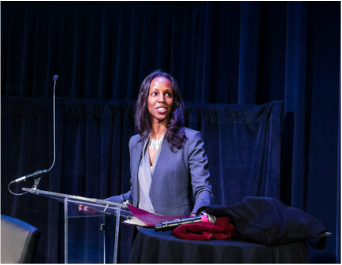 Sarah Lewis. Photo Yassine El Mansouri. Sarah Lewis. Photo Yassine El Mansouri. During the Education panel, Howard Gardner spoke about how the humanities once were seen as invaluable, but now sciences have largely taken the lead. Except in the work of technology where arts, design, and science come together. The following panel was dedicated to showing the deep and integral connection of the arts to technology. Megan Smith (United States Chief Technology Officer, Office of Science and Technology): She began by explaining that the universe doesn’t divide the arts and humanities from math and sciences. This is something that we do and much to our won detriment, especially when it comes to race and gender. We’ve made huge mistakes through unconscious bias. We‘ve left so many cultures and communities out of the celebration. She spoke about the Bechdel Test and the significant impact of the diversity and gender parity in the Google Doodle. Racism and misogyny erase our history. We have to lift the prioritization of diversity and inclusion. It’s a waste of talent if we don’t. Alan Kay (Computer Scientist): He continued the conversation about the intersection of arts and science. Science, math, and engineering come together to map our world; this is how we understand our geographical landscape and where we are in their world. The universe does not divide art and science, math and humanities. We are negotiating systems of the universe and nature, our social systems—including race, class, and gender, and also the internet. The internet is the most important thing since the printing press, but writing is more important than both. With regards to all of these systems, it’s not about achieving perfection rather it’s about the ability to detect and correct errors as they arise. It’s about making progress rather than winning or losing. With the arts, how do we address our unconscious bias? Sarah Lewis (Art historian and a Du Bois Fellow at Harvard University): She spoke about how art is a technology for getting us to see beyond our collective failures, which she also addresses in her book, “The Rise: Creativity, the Gift of Failure and the Search for Mastery.” The purpose of the arts is to get us to focus. Louis Armstrong realized that his trumpet playing allowed him to walk towards justice. One aesthetic work of any kind moves us towards understanding and can change the world. The access that technology gives us is extraordinary, but can it limit our ability, passion, and sense of urgency to move us toward justice. Also, we live in an increasingly polarized climate. We no longer live in close proximity of those with divergent views. How do we draw attention to the fact that the arts bring us together? Reason alone is not enough to make man good. This is how art, the appreciation of art, can bring us together with a common humanity. Arts Summit: Free SpeechViolinist Johnny Gandelsman and performer Heather Raffo opened the afternoon session with music and a staged reading. Raffo performed a monologue about a mother who lost her son in the massacre at Sandy Hook; the death of a young man in Bagdad; a young woman desiring an education in Iraq; a young woman who was held as a sexual slave in Ohio; a young woman who fights for education for other young women, is shot, but survives and speaks about the need for education for women around the world; and a young girl who desires freedom, but doesn’t understand the dangers that surround her and learns how to hide in silence in case a gunman comes to kill them. The piece ends with a poignant question: “Is survival silent?” From there, we turned our attention to a conversation around free speech. As a playwright, what I love about theatre is that it’s a space that holds multiple truths and perspectives. It’s a place where beliefs can be challenged, people can be held accountable, and we can all be shown a way forward. The issue of free speech is more than creative and self-expression, it also a matter of law, morality, and financial impact. 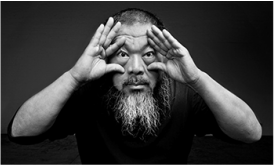 Ai Weiwei, Artist and Advocates for Human Rights and Freedom of Speech. Ai Weiwei, Artist and Advocates for Human Rights and Freedom of Speech. Ai Weiwei joined us by video as he is not able to leave China. No limits on freedom of speak. Freedom of speech is essential to creativity. As artists, our work is to express ourselves. We have to trust humanity and put an effort into our future generation. An artist is the person who bears the responsibility and leaves the traces for future generations to understand what we experienced today. The artists and arts institution have the opportunities to explore what is happening beyond their boundaries. The government has a responsibility to support the artists and in doing so will help to cultivate a better society. In a society with limits free speech and a disregard for human rights, it is a privilege to create art that speaks to social change. Kate Levin (Former Commissioner of the New York City Department of Cultural Affairs): She reminded us that she was commissioner during the culture wars of 1980s and 90s, when right-wing politicians and religious leaders not only attacked the NEA for supporting artists and venues engaged in “anti-Christian bigotry,” but also passed legislation forbidding the NEA from funding artists and institutions that “promote, disseminate or produce obscene or indecent materials.” The stakes for freedom of speech in the arts not only impact the financial health of artists, but also the public trusts in arts institutions. David Brooks (Op-Ed Columnist, The New York Times): He began by responding to a prompt about triggers warnings. He said that we have a commitment and conviction problem not a freedom of speech problem. Young people have a challenge to committing to education, careers, families, etc. The arts teach us about new things to love and then we form a conviction. Ultimately, cultural controversies are about respect. How you provoke and provide a context in which other people can think, process, and be challenged. There’s a group of people who we give a great deal of respect to and others who we consider counter cultural clowns. The cultural clowns say things that we need to have said, but they aren’t accorded the same amount of respect. Oskar Eustis (Artistic Director of The Public Theater) – He began by responding to a prompt about the role of creative expression, moral responsibility, and historical representation. Artists have the responsibility to tell the story through their point of view. The challenge is categorization. Historical fiction is what is being made up, but we have to ask why is it being made up and who is making it up? What is the ideological context and point of view? Human beings are political animals. Our social relationships are core of who we are. Theatre celebrates that. We have to allow for a full cacophony of voices to be heard. We have to learn how to talk about things that matter most in a way that people will understand and respond. We have to empower people to take part in a conversation. Justice Sonia Sotomayor (Associate Justice of the U.S. Supreme Court): She began by explaining that the job of the court around free speech has to look at the context and where the speech resonates. Society changes and what is acceptable in society in changes. The law cannot take care of moral corruption only education can. Laws are gray; there is no black and white, which is why you have judges. As a society, we are in a discussion about what is permissible and what isn’t. You can’t separate politics from human emotions. If the law is blind, we wouldn’t move forward or progress as a nation. As we advance as a nation, the law is impacted by where society is at a given time, which allows for empathy. By nature of her job, self-censorship is an everyday part of her life. Morality is an aspect of self-censorship, this idea that it’s not just bad for me, but bad for the people around me. Arts Summit: Race Maz Jobrani. Photo Yassine El Mansouri. Maz Jobrani. Photo Yassine El Mansouri. Last year, I was asked to take part in a conversation on HowlRound.com about Race and Representation in the American Theatre. In response to the prompt, “Who is allowed to tell whose stories onstage”, I wrote an essay entitled, Writing Towards the Specific, and shared this perspective: “As playwrights, we are image makers. The work we do has significant and lasting impact on perception. This is why social awareness, cultural literacy, and racial consciousness are essential to our work. This is what makes the issue of writing outside of our ethnicity—always and exceedingly—about more than just a desire to share your truth, experience, curiosity, and admiration. Playwrights, all of us, need to understand that owing to limited representations in mass media, the way we write women and people of color impacts how women and people of color are perceived in everyday life.” I thought about this as I delighted in actor and comedian Maz Jobrani’s searing and pointed comic performance. He spoke about the he impact of racism across cultures and the real world consequences to the images of stereotypical portrayal of people of color. 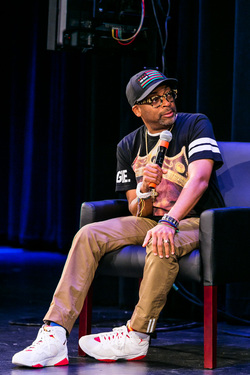 Spike Lee. Photo Yassine El Mansouri. Spike Lee. Photo Yassine El Mansouri. It seemed fitting that our panel discussion about race featured Spike Lee ((Writer, Director, Founder, 40 Acres and a Mule Filmworks), whose brilliant, poignant, and uncompromising creative vision and social activism has been equally praised and criticized. Darren Walker (President, Ford Foundation) asked a series of questions and, true to form, Lee answered some of them. Walker pushed as hard as he could, but Lee knows that he cannot solve the problem of race in America. He can only speak from his own perspective. It was a fast paced conversation and I found myself wanting to listen more actively than just observe. However, I was able to capture the most compelling moments of this exchange about racism in Hollywood: SPIKE LEE: America has a love/hate with black people. DARREN WALKER: Are we being too simplistic to say there’s a dichotomy? SPIKE LEE: Our history is intertwined, but we’re still not in leadership positions. The film industry is racist. Racism is ingrained in our culture. Bamboozled is a film about the misrepresentation of black people, but it could have been made about women, homosexuals, Hispanics, Native Americans. America is the most powerful nation in the word because of the exploitation of culture. Who is validating and heralding the stories and art that was great, but who had the vote? In 1990, Driving Miss Daisy won Best Picture of the Year. Driving Miss Daisy. DARREN WALKER: But it’s an important historical film. SPIKE LEE: Important? What? How you gonna say? But who had the vote? Who was voting for that? Then Walker ask Lee about his new documentary CHIRAQ, which is about the violence that plagues parts of Chicago. The film and title, which Lee did not invent, has received a great deal of criticism from politicians, civic leaders, and community members. Lee has spoken at some length about the new film, but here's what he had to say to us: SPIKE LEE: There have been more people killed in black on black violence in Chicago than U.S. soldiers in both wars in Iraq. But we’re not supposed to talk about it. Listen, art is not a popularity contest. To which Walker conceded: DARREN WALKER: That’s right. Artists continue to challenge us, hold a mirror up to us, make us uncomfortable, and they won’t let us forget. They won’t let us sit in our privilege. Arts Summit: Reflection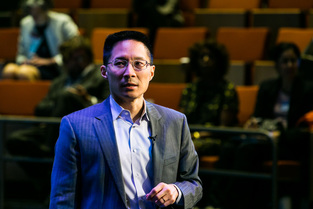 Eric Liu. Photo Yassine El Mansouri. Eric Liu. Photo Yassine El Mansouri. To close our time together, Eric Liu (Founder and CEO, Citizen University) reflected back the experience of our time together. He noticed three urgent themes: Integration: There is a need for a deeper sense of integration, no separation of categories. We have to resist the natural temptation to separate and categorize. We are one body. We are integrated. Art reminds us of that in the most powerful way. Embodiment of patterns: Art is our pattern language. We are learning a language when we learn art. Art reminds us of a pattern of relationships. Art reminds us of the pattern of argument and context. Art also teaches us how to step out of our context, out of practice patterns of behavior, and to overturn our expectations and challenge preexisting patterns Practice of Power: Power is an uncomfortable conversation. We haven’t found a way to talk about the dynamic of power and the role of power to create or deny opportunity. We don’t know how to negotiate those willing to speak truth to power and those who say we don’t like the status quo. We need a greater literacy in power, so that art can be used to challenge or reinforce forms of power. 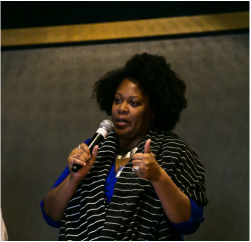 Jacqueline E. Lawton. Photo by Yassine El Mansour Jacqueline E. Lawton. Photo by Yassine El Mansour Then Liu offered the following points that I took as action steps in our work to use art as a tool for social justice and change: 1. We know that art can bridge divides of understating and can activate empathy, but it can also prepare each of us to be active citizens. 2. The underserved are actually the uninvited. We need to think of these people and communities as folks who need to be invited to be a part of the conversation and creation of art. 3. We need to flip the frame of how we talk about inclusion. We went from acknowledge diversity to celebrating diversity and now we need to progress toward what we do with diversity. After a moving performance from MusiCorps and Camille Zamora, we adjourned to the Terrace Gallery to enjoy cocktails, hors d’oeurves, the beginning of a beautiful rain storm, and the DC Youth Orchestra Violin Quartet. It was the perfect ending to a rich, full, and powerful discussion of art and civic life. I appreciated so much that art was front and center and that young people were invited to take part in the conversation. And as I prepare for TCG’s 2015 National Conference, I am mindful of carving out new pathways and to both widening and strengthening the rugged roads of progress. Collection of Photos of the Day by Yassine El MansouriAbout the John F. Kennedy Center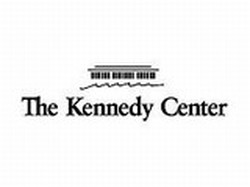 The John F. Kennedy Center for the Performing Arts is America’s living memorial to President Kennedy. Under the leadership of Chairman David M. Rubenstein and President Deborah F. Rutter, the nine theaters and stages of the nation’s busiest performing arts facility attract audiences and visitors totaling 3 million people annually; Center-related touring productions, television, and radio broadcasts welcome 40 million more. Opening its doors on September 8, 1971, the Center presents the greatest performances of music, dance, and theater; supports artists in the creation of new work; and serves the nation as a leader in arts education. With its artistic affiliates, the National Symphony Orchestra and Washington National Opera, the Center’s achievements as a commissioner, producer, and nurturer of developing artists have resulted in more than 300 theatrical productions, and dozens of new ballets, operas, and musical works. Each year, millions of people nationwide take part in innovative, inclusive, and effective education programs initiated by the Center, including school- and community-based residencies and consultancies; age-appropriate performances and events for young people; career development for young actors, dancers, singers, and instrumentalists; and professional learning opportunities for teachers, teaching artists, and school administrators. These programs have become models for communities across the country. The Center’sEnsuring the Arts for Any Given Child program works with selected local school districts and seeks to provide a comprehensive arts education to children K-8. The Center also has been at the forefront of making the performing arts accessible to persons with disabilities, highlighted by the work accomplished with its affiliate, VSA. As part of the Kennedy Center’s Performing Arts for Everyone outreach program, the Center stages more than 400 free performances of music, dance, and theater by artists from throughout the world each year on the Center’s main stages, and every evening at 6 p.m. on the Millennium Stage. The Rubenstein Arts Access Program expands the Center’s efforts to make the arts accessible to children, young adults, and to people who have little or limited ability to attend and enjoy the performing arts, enabling audiences to engage in more ways, at more times, and in more places than ever before. For more information about the Kennedy Center, please visit www.kennedy-center.org About the Aspen Institute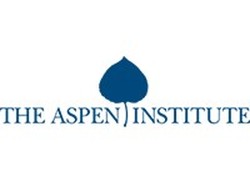 The Aspen Institute is an educational and policy studies organization based in Washington, DC. Its mission is to foster leadership based on enduring values and to provide a nonpartisan venue for dealing with critical issues. The Institute is based in Washington, DC; Aspen, Colorado; and on the Wye River on Maryland’s Eastern Shore. It also has offices in New York City and an international network of partners. The Aspen Institute Arts Program was established to support and invigorate the arts in America, and to return them to the center of the Aspen Institute’s “Great Conversation.” Directed by Damian Woetzel, it brings together artists, advocates, educators, managers, foundations, and government officials to exchange ideas and develop policies and programs that strengthen the reciprocal relationship between the arts and society. Program activities include: the Race, Arts, and America initiative; ArtStrikes; the annual Aspen Seminar for Student Poets; curated conversations and performances; the Washington Ideas Roundtable; the New Views Documentaries and Dialogue series; the Aspen Arts Strategy Group, which convenes leaders in the arts and other sectors in various American cities to strategize on ways the arts can assist in education or community development; and the Harman-Eisner Artist in Residence Program, in which distinguished artists participate in Institute programs throughout the year. For more information about the Aspen Institute, please visit www.aspeninstitute.org/artsprogram
0 Comments
Your comment will be posted after it is approved.
Leave a Reply. |
My BlogI'm a playwright, dramaturg, and teaching artist. It is here where you'll find my queries and musings on life, theater and the world. My posts advocate for diversity, inclusion, and equity in the American Theatre and updates on my own work. Please enjoy!
Categories
All
Archives
June 2020
Reading List
|
